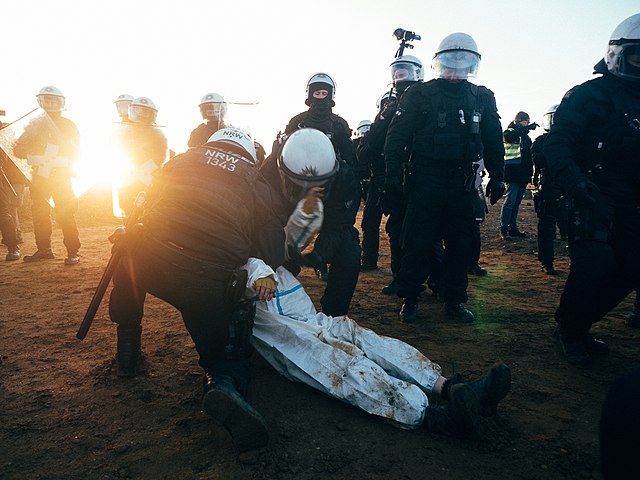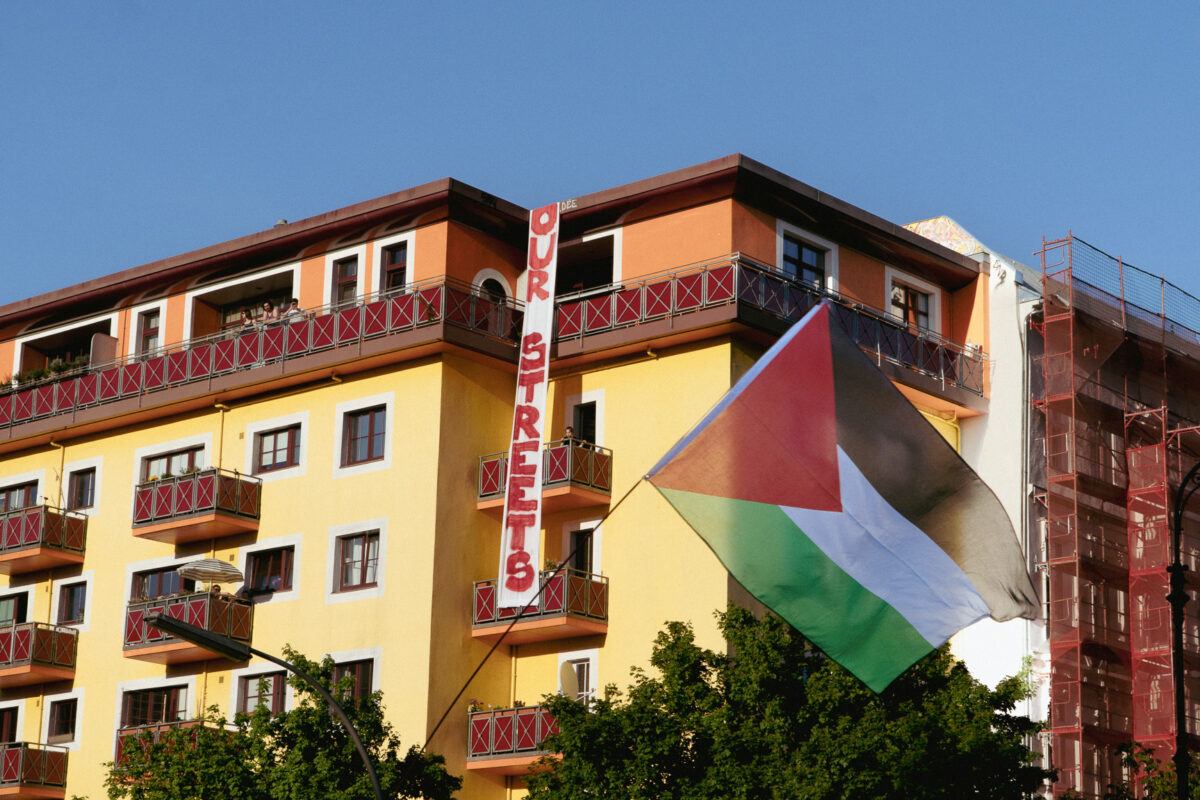It has been almost two months since the village Lützerath in the German Rhineland, as well as the protest camp that had been established in it two and a half years prior, were evicted and destroyed by a coalition between the German police and the energy company RWE. The images of the eviction and protests were seen around the globe and ranged from distressing to sometimes downright absurd, like that of a monk, ridiculing police officers that were stuck in the mud.
One photo, taken by the photojournalist Marius Michusch, has been shared particularly often and appears to sum up at least one aspect of the conflict almost perfectly. The image, taken at night, shows police in riot gear, standing in front of the edge of the coal mine Garzweiler, the bucket wheel of the coal excavator behind them eerily lit up. This photograph represents with a startling clarity not only the destructiveness of the fossil age, but also the entanglements between the interests of energy giants such as RWE and state powers (legislative, judicative, executive).
But in order to understand the conflict around Lützerath, we have to take a look back into its history, rather than only consider the final battle in January. The village Lützerath was sitting on several hundred million tons of lignite coal that to this day still remains in the ground. Coal that is, according to expert reports from the German Institute for Economic Research, not only unnecessary to ensure German energy security, but that will also, once burnt, make it impossible for Germany to keep within the limits of the internationally ratified Paris Agreement.
The stakes around the village have thus been high from the very start. But Lützerath is far from being the first village in Germany to be destroyed for the sake of lignite extraction. Over 130 villages have thus far been destroyed in Germany alone in order to extract the coal that lies below them. That this process has been possible at all is thanks to a law that dates back to the Nazi era, enabling the expropriation of people whose houses are located above coal deposits.
Local resistance against the environmental devastation that comes with coal mining has existed for decades, even if it only really recently started to draw attention beyond the local area. Famously, activists succeeded to defend the Hambach Forest in 2018 with very similar methods to the ones employed in Lützerath, and many of the activists who were present in Hambach had come to support the protests in Lützerath as well.
**Editor’s note: The use of tripods and treehouses seen today in occupations around the world, including in both Hambach and Lützerath, has steadily gained popularity over the past decades. One of the first actions using these tactics that was widely covered in the media was that which came to be known as ‘The War in the Woods,” where activists intended to stop clear-cutting in Clayoquot Sound, Canada. It was the country’s largest act of civil disobedience until the 2021 Fairy Creek blockades.
But one significant thing changed since the protests against the destruction of the Hambach Forest. During the conflict around the Hambach Forest, the German Green Party was still in the opposition in both North Rhine-Westphalia and on a federal level. Many of its party members, amongst them Mona Neubaur, who is today the minister for economics in North Rhine Westphalia, had campaigned alongside the activists for the preservation of the forest and for an earlier end to coal in Germany.
But when the battle began to intensify, the situation changed. In 2021, the Green Party became a member of the ruling coalition of Germany on a federal level. In their coalition treaty, the “progress coalition” made up of social democrats, liberals and greens noted that the German exit from coal should “ideally” happen by 2030. The previous government had aimed for a coal exit strategy by 2038. But Lützerath was not saved by political decision makers. The coalition treaty, which saved five other villages in the Rhenish mining district, refrained from making a clear statement on the village, and instead stated that courts should decide about the future of the village.
Many in the climate movement saw this as a cop-out: The majority of the remaining coal in the area was estimated to be underneath Lützerath. Given the enormous power of RWE in the region, as well as a legal framework not yet sufficiently adapted to the reality of the climate crisis, it seemed predictable that courts would decide in favour of the energy giant, rather than in favour of the last remaining legal inhabitant of the village. And they did. Eckhardt Heukamp, who had stood in solidarity with the climate activists and who had resisted against his expropriation in the courts for years, lost the legal battle and left his childhood home in early October 2022.
“A milestone for the climate”
The whole situation was further exacerbated by the Russian invasion of Ukraine in February 2022. The Green Party, of all parties, now had to pay for years of negligent energy politics and German dependency on Russian gas. Maybe that’s why, eager to break some good news, Mona Neubaur and Robert Habeck announced their partial compliance with the coalition treaty in October 2022 as a milestone for the climate: the exit of coal extraction in the Rhenish mining area would be brought forward, as promised in the coalition treaty, to 2030. Lützerath was portrayed as a last, necessary victim, an endpoint to a chapter soon to be closed.
But the announcement quickly drew criticism. Not only did Habeck and Neubaur announce this decision together with Markus Krebber, CEO of RWE, after closed-door negotiations. Climate scientists and activists alike were quick to point out that the phase-out may have been brought forward in time, but mathematically it did not lead to sufficient CO2 savings to stay within the limits of the Paris agreement. Justified by the energy crisis, the coal-fired power plants were to be utilised more in the short term, effectively leading to almost no CO2 savings.
Neubaur, Habeck and RWE justified their decision with expert reports. However, the ones they referred to were widely criticized by media outlets such as Der Spiegel. The magazine considered them as rushed, insufficiently referenced and based on rough estimations. Other independent reports continued to state that there was still no need for the coal underneath the village. Unsurprisingly then, the refusal by the Green party to declare a demolition moratorium for Lützerath was seen by many in the climate movement as at best, a failure of the Greens, and at worst, outright treason.
It was this disappointment in a party that – many had hoped – would bring about more consequent climate action, combined with an unwavering sense of urgency after yet another summer of tangible climate breakdown, that mobilized thousands to come together when the eviction of the protest camp started in early January 2023.
But even though the movement had mobilized tens of thousands of protesters to contest the destruction of the village, police from all over Germany worked hand in hand with workers from RWE to evict the protesters. While the officers were still removing activists from trees, workers cut down trees right behind them. Given strong winds and overall bad weather conditions in early January, many activists lamented having been endangered by rushed police work. RWE even provided the police with vans to transport the prisoners. Where Lützerath could have been an end point to the fossil age, it instead turned into a lesson on the ways in which the interests of energy giants are protected and enforced by state powers, et the expense of the shared interest of humanity to keep planet earth habitable.
And yet, it would be false to claim that the resistance against the destruction of Lützerath was in vain. Climate activists have announced that they will keep on fighting against the advancement of the coal mine for as long as the coal remains in the ground. While the village and protest camp themselves have been destroyed, the two and a half years of active resistance forged alliances between rural populations and activists; the experiences made and lessons learned from the fight for Lützerath will stay within the memory of the movement.
Further, the media reported widely on the battle on the fields around Lützerath, which served to unmask the way in which the existing system continues to protect the interests of energy companies such as RWE. And lastly, if nothing else, the battle showed once again that grassroots organizing is a highly effective means in contesting power and shifting the dialogue where institutionalized politics fail.




